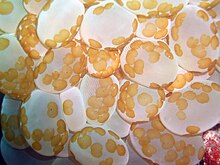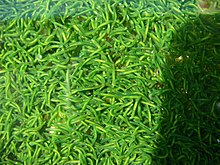Acoelomorpha
| Acoelomorpha | |
|---|---|

| |
| The acoelomorph Waminoa sp. (orange structure) on the Plerogyra sp. coral (whitish bubbles). | |
| Scientific classification | |
| Domain: | Eukaryota |
| Kingdom: | Animalia |
| Phylum: | Xenacoelomorpha |
| Subphylum: | Acoelomorpha Ehlers, 1985 |
| Classes | |
Acoelomorpha is a subphylum of very simple and small soft-bodied animals with planula-like features which live in marine or brackish waters. They usually live between grains of sediment, swimming as plankton, or crawling on other organisms, such as algae and corals.[1] With the exception of two acoel freshwater species, all known acoelomorphs are marine.[2]
Systematics[edit]
Etymology[edit]
The term "acoelomorph" derives from the Ancient Greek words ἀ (a), the alpha privative, expressing negation or absence, κοιλία (koilía), meaning "cavity", and μορφή (morphḗ), meaning "form".[3][4] This refers to the fact that acoelomorphs have a structure lacking a fluid-filled body cavity.
Classification[edit]


The subphylum Acoelomorpha is divided into two classes. There are at least 408 described species, with a majority of these falling within the Crucimusculata infraorder in Acoela.
- Acoela comprise small flattened worms, classified into a dozen families.[6]
- Nemertodermatida comprise millimetre-sized, mostly interstitial worms, distributed into two families.[7]
Phylogeny[edit]
The soft bodies of acoelomorphs and the lack of some of the key bilaterian traits make them difficult to classify.[8][9] Traditionally, based on phenotypic features, acoelomorphs were considered to belong to the phylum Platyhelminthes, which was long seen as the sister group to all other bilaterian phyla.[10] However, a series of molecular phylogenetics studies at the hinge between the 20th and 21st centuries demonstrated that they are fast-evolving organisms not closely related to platyhelminthes,[11][12][13][14] therefore involving the polyphyly of flatworms.[15][16][17][18]
Actually, Acoelomorpha appeared to constitute a separate, deep-branching phylum, kingpin of bilaterian evolution.[19] Yet their evolutionary affinities remain enigmatic as they might be the sister-group either to all other bilateral animals[15][16][17] or to all deuterostomes.[18] Resolving this debate would indicate whether acoelomorphs are simple or simplified. If they are the sister group to Bilateria, it would point to a simple body plan for the first bilaterian. Alternatively, if acoelomorphs are related to deuterostomes, this would imply that their organisation is the result of secondary simplification.[20]

In addition, comparative analyses of morphological, developmental, and molecular characters raised two points.
- Xenoturbellida is the sister group to acoelomorphs, constituting the so-called Xenacoelomorpha clade.[21] The close evolutionary relationship between Acoelomorpha and Xenoturbella is supported by the morphology (structure of epidermal cilia[22]), the embryology (direct development without a feeding larval stage[23]), and the concatenation of hundreds of proteins.[24][21][25]
- The phylogenetic placement of Xenacoelomorpha among bilaterian animals is not yet well defined, despite increased taxon and gene sampling, (re)-analyses of published data sets, and use of more sophisticated models of sequence evolution in phylogenomic studies. There is a conflict between two evolutionary hypotheses, with Xenacoelomorpha being the sister group to Ambulacraria within deuterostomes (i.e., the Xenambulacraria hypothesis) on the one hand,[26] and Xenacoelomorpha as sister group to all other bilaterians (i.e., the Nephrozoa hypothesis) on the other.[25][27][28] However, the Nephrozoa hypothesis might reflect methodological errors resulting from model violations in the phylogenomic inference.[26]
Anatomy[edit]

Acoelomorphs resemble flatworms in many respects, but have a simpler anatomy, not even having a gut. Like flatworms, they have no circulatory or respiratory systems, but they also lack an excretory system. They lack body cavities (acoelomate structure), a hindgut or an anus.[1]
The epidermal cells of acoelomorphs are unable to proliferate, a feature that is only shared with rhabditophoran flatworms and was for some time considered a strong evidence for the position of Acoelomorpha within Platyhelminthes. In both groups, the epidermis is renewed from mesodermal stem cells.[29]
The nervous system of acoelomorphs is formed by a set of longitudinal nerve bundles beneath the ciliated epidermis. Close to the anterior end, these bundles are united by a ring commissure, but do not form a true brain, although it is hypothesized that such organization was the precursor of the cephalization of the nerve system in more derived bilaterians.[30] After decapitation, such a "brain" (rather, a cerebroid ganglion) regenerates in a few weeks.[31]
The sensory organs include a statocyst – which presumably helps them orient to gravity –, and, in some cases, ancestral pigment-spot ocelli capable of detecting light.[32]
Acoelomorphs are simultaneous hermaphrodites, but have no gonads and no ducts associated with the female reproductive system. Instead, gametes are produced from the mesenchymal cells that fill the body between the epidermis and the digestive vacuole.[32]
References[edit]
- ^ a b Cannon, L. R. G. (1986) Turbellaria of the World. A guide to families and genera. Brisbane, Queensland Museum, 136 p.
- ^ Harzsch, Steffen; Purschke, Günter (2016-01-01). Structure and evolution of invertebrate nervous systems. Oxford University Press. pp. 56–61. ISBN 978-0-19-968220-1. OCLC 951605913.
- ^ Bailly, Anatole (1981-01-01). Abrégé du dictionnaire grec français. Paris: Hachette. ISBN 2010035283. OCLC 461974285.
- ^ Bailly, Anatole. "Greek-french dictionary online". www.tabularium.be. Retrieved 2020-02-27.
- ^ Achatz, Johannes G.; Chiodin, Marta; Salvenmoser, Willi; Tyler, Seth; Martinez, Pedro (2013-06-01). "The Acoela: on their kind and kinships, especially with nemertodermatids and xenoturbellids (Bilateria incertae sedis)". Organisms Diversity & Evolution. 13 (2): 267–286. doi:10.1007/s13127-012-0112-4. ISSN 1618-1077. PMC 3789126. PMID 24098090.
- ^ Tyler, S.; Artois, T.; Schilling, S.; Hooge, M.; Bush, L.F., eds. (2006–2020). "World List of turbellarian worms: Acoelomorpha, Catenulida, Rhabditophora. Acoela". www.marinespecies.org. WoRMS - World Register of Marine Species. Retrieved 2020-02-12.
- ^ Tyler, S.; Artois, T.; Schilling, S.; Hooge, M.; Bush, L.F., eds. (2006–2020). "World List of turbellarian worms: Acoelomorpha, Catenulida, Rhabditophora. Nemertodermatida". www.marinespecies.org. WoRMS - World Register of Marine Species. Retrieved 2020-02-12.
- ^ Petrov, A.; Hooge, M.; Tyler, S. (2006). "Comparative morphology of the bursal nozzles in acoels (Acoela, Acoelomorpha)". Journal of Morphology. 267 (5): 634–648. doi:10.1002/jmor.10428. PMID 16485278. S2CID 32595353.
- ^ Laden, Greg (2009-10-01). "Why You Should Care About Acoelomorph Flatworms". Smithsonian Magazine. Retrieved 2020-03-02.
- ^ Conway-Morris, S.; George, J. D.; Gibson R.; Platt, H. M. (1985) The Origins and relationships of lower invertebrates. Oxford, Clarendon Press, 397 p.[page needed]
- ^ Katayama, Tomoe; Yamamoto, Masamichi; Wada, Hiroshi; Satoh, Noriyuki (1993). "Phylogenetic Position of Acoel Turbellarians Inferred from Partial 18S rDNA Sequences" (PDF). Zoological Science. 10 (3): 529–536. ISSN 0289-0003. PMID 7764139.
- ^ Katayama, T.; Wada, H.; Furuya, H.; Satoh, N.; Yamamoto, M. (1995-10-01). "Phylogenetic Position of the Dicyemid Mesozoa Inferred from 18S rDNA Sequences". The Biological Bulletin. 189 (2): 81–90. doi:10.2307/1542458. ISSN 0006-3185. JSTOR 1542458. PMID 8541419.
- ^ Carranza, S.; Baguñà, J.; Riutort, M. (1997-05-01). "Are the Platyhelminthes a monophyletic primitive group? An assessment using 18S rDNA sequences". Molecular Biology and Evolution. 14 (5): 485–497. doi:10.1093/oxfordjournals.molbev.a025785. ISSN 0737-4038. PMID 9159926.
- ^ Ruiz-Trillo, Iñaki; Riutort, Marta; Littlewood, D. Timothy J.; Herniou, Elisabeth A.; Baguñà, Jaume (March 1999). "Acoel Flatworms: Earliest Extant Bilaterian Metazoans, Not Members of Platyhelminthes". Science. 283 (5409): 1919–1923. Bibcode:1999Sci...283.1919R. doi:10.1126/science.283.5409.1919. ISSN 0036-8075. PMID 10082465.
- ^ a b Baguñà, J.; Riutort, M. (2004). "Molecular phylogeny of the Platyhelminthes". Canadian Journal of Zoology. 82 (2): 168–193. doi:10.1139/z03-214.
- ^ a b Baguñà, Jaume; Riutort, Marta (2004). "The dawn of bilaterian animals: the case of acoelomorph flatworms". BioEssays. 26 (10): 1046–57. doi:10.1002/bies.20113. PMID 15382134. S2CID 40453683.
- ^ a b Ruiz-Trillo, Iñaki; Riutort, Marta; Fourcade, H. Matthew; Baguñà, Jaume; Boore, Jeffrey L. (2004). "Mitochondrial genome data support the basal position of Acoelomorpha and the polyphyly of the Platyhelminthes". Molecular Phylogenetics and Evolution. 33 (2): 321–32. doi:10.1016/j.ympev.2004.06.002. PMID 15336667.
- ^ a b Philippe, Hervé; Brinkmann, Henner; Martinez, Pedro; Riutort, Marta; Baguñà, Jaume (2007-08-08). Volff, Jean-Nicolas (ed.). "Acoel Flatworms Are Not Platyhelminthes: Evidence from Phylogenomics". PLOS ONE. 2 (8): e717. doi:10.1371/journal.pone.0000717. ISSN 1932-6203. PMC 1933604. PMID 17684563.
- ^ Haszprunar, G. (1996). "Plathelminthes and Plathelminthomorpha — paraphyletic taxa". Journal of Zoological Systematics and Evolutionary Research. 34 (1): 41–48. doi:10.1111/j.1439-0469.1996.tb00808.x. ISSN 1439-0469.
- ^ Ruiz-Trillo, Iñaki; Paps, Jordi (2016-06-01). "Acoelomorpha: earliest branching bilaterians or deuterostomes?". Organisms Diversity & Evolution. 16 (2): 391–399. doi:10.1007/s13127-015-0239-1. hdl:1983/2686c832-dffe-4486-b3b2-17d4966fd64e. ISSN 1618-1077.
- ^ a b Philippe, H.; Brinkmann, H.; Copley, R. R.; Moroz, L. L.; Nakano, H.; Poustka, A. J.; Wallberg, A.; Peterson, K. J.; Telford, M. J. (2011). "Acoelomorph flatworms are deuterostomes related to Xenoturbella". Nature. 470 (7333): 255–258. Bibcode:2011Natur.470..255P. doi:10.1038/nature09676. PMC 4025995. PMID 21307940.
- ^ Lundin, K (1998). "The epidermal ciliary rootlets of Xenoturbella bocki (Xenoturbellida) revisited: new support for a possible kinship with the Acoelomorpha (Platyhelminthes)". Zoologica Scripta. 27 (3): 263–270. doi:10.1111/j.1463-6409.1998.tb00440.x. S2CID 85324766.
- ^ Nakano, H.; Lundin, K.; Bourlat, S. J.; Telford, M. J.; Funch, P.; Nyengaard, J. R.; Obst, M.; Thorndyke, M. C. (2013). "Xenoturbella bocki exhibits direct development with similarities to Acoelomorpha". Nature Communications. 4: 1537–. Bibcode:2013NatCo...4.1537N. doi:10.1038/ncomms2556. PMC 3586728. PMID 23443565.
- ^ Hejnol, Andreas; Obst, Matthias; Stamatakis, Alexandros; Ott, Michael; Rouse, Greg W.; Edgecombe, Gregory D.; Martinez, Pedro; Baguñà, Jaume; Bailly, Xavier; Jondelius, Ulf; Wiens, Matthias (2009-12-22). "Assessing the root of bilaterian animals with scalable phylogenomic methods". Proceedings of the Royal Society B: Biological Sciences. 276 (1677): 4261–4270. doi:10.1098/rspb.2009.0896. PMC 2817096. PMID 19759036.
- ^ a b Edgecombe, G. D.; Giribet, G.; Dunn, C. W.; Hejnol, A.; Kristensen, R. M.; Neves, R. C.; Rouse, G. W.; Worsaae, K.; Sørensen, M. V. (2011). "Higher-level metazoan relationships: Recent progress and remaining questions" (PDF). Organisms Diversity & Evolution. 11 (2): 151–172. doi:10.1007/s13127-011-0044-4. S2CID 32169826.
- ^ a b Philippe, Hervé; Poustka, Albert J.; Chiodin, Marta; Hoff, Katharina J.; Dessimoz, Christophe; Tomiczek, Bartlomiej; Schiffer, Philipp H.; Müller, Steven; Domman, Daryl; Horn, Matthias; Kuhl, Heiner; Timmermann, Bernd; Satoh, Noriyuki; Hikosaka-Katayama, Tomoe; Nakano, Hiroaki; Rowe, Matthew L.; Elphick, Maurice R.; Thomas-Chollier, Morgane; Hankeln, Thomas; Mertes, Florian; Wallberg, Andreas; Rast, Jonathan P.; Copley, Richard R.; Martinez, Pedro; Telford, Maximilian J. (2019). "Mitigating Anticipated Effects of Systematic Errors Supports Sister-Group Relationship between Xenacoelomorpha and Ambulacraria". Current Biology. 29 (11): 1818–1826.e6. doi:10.1016/j.cub.2019.04.009. hdl:21.11116/0000-0004-DC4B-1. ISSN 0960-9822. PMID 31104936. S2CID 155104811.
- ^ Srivastava, M.; Mazza-Curll, K. L.; Van Wolfswinkel, J. C.; Reddien, P. W. (2014). "Whole-Body Acoel Regeneration is Controlled by Wnt and Bmp-Admp Signaling". Current Biology. 24 (10): 1107–13. doi:10.1016/j.cub.2014.03.042. PMID 24768051.
- ^ Cannon, Johanna Taylor; Vellutini, Bruno Cossermelli; Smith, Julian; Ronquist, Fredrik; Jondelius, Ulf; Hejnol, Andreas (2016). "Xenacoelomorpha is the sister group to Nephrozoa". Nature. 530 (7588): 89–93. Bibcode:2016Natur.530...89C. doi:10.1038/nature16520. PMID 26842059. S2CID 205247296.
- ^ Michalak, Pawel; Egger, Bernhard; Steinke, Dirk; Tarui, Hiroshi; De Mulder, Katrien; Arendt, Detlev; Borgonie, Gaëtan; Funayama, Noriko; Gschwentner, Robert; Hartenstein, Volker; Hobmayer, Bert; Hooge, Matthew; Hrouda, Martina; Ishida, Sachiko; Kobayashi, Chiyoko; Kuales, Georg; Nishimura, Osamu; Pfister, Daniela; Rieger, Reinhard; Salvenmoser, Willi; Smith, Julian; Technau, Ulrich; Tyler, Seth; Agata, Kiyokazu; Salzburger, Walter; Ladurner, Peter (2009). "To Be or Not to Be a Flatworm: The Acoel Controversy". PLOS ONE. 4 (5): e5502. doi:10.1371/journal.pone.0005502. PMC 2676513. PMID 19430533.
- ^ Perea-Atienza, E.; Gavilan, B.; Chiodin, M.; Abril, J. F.; Hoff, K. J.; Poustka, A. J.; Martinez, P. (2015). "The nervous system of Xenacoelomorpha: a genomic perspective". Journal of Experimental Biology. 218 (4): 618–28. doi:10.1242/jeb.110379. hdl:2445/192702. PMID 25696825.
- ^ Sprecher, Simon G.; & al. (2015). "Functional brain regeneration in the acoel worm Symsagittifera roscoffensis". Biology Open. 4 (12): 1688–1695. doi:10.1242/bio.014266. PMC 4736034. PMID 26581588.
- ^ a b Barnes, Robert D. (1982). Invertebrate Zoology. Philadelphia, PA: Holt-Saunders International. p. 229. ISBN 978-0-03-056747-6.
